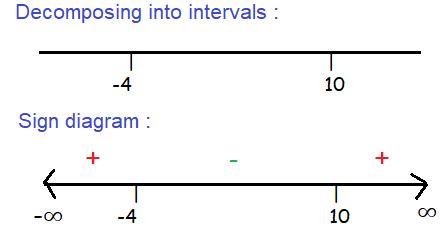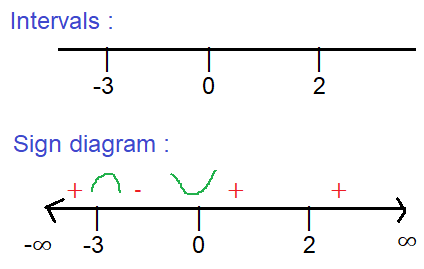AP CALCULUS PRACTICE PROBLEMS ON DERIVATIVE
Subscribe to our ▶️ YouTube channel 🔴 for the latest videos, updates, and tips.
Problem 1 :
For what value of x does the function
f(x) = x3 - 9x2 - 120x + 6
have a local minimum ?
A) 10 B) 4 C) -4 D) -10
Solution :
To find at which value of x, the function f(x) has local minimum. Let us find the critical number and draw the sign diagram.
f(x) = x3 - 9x2 - 120x + 6
f'(x) = 3x2 - 9(2x) - 120(1)
f'(x) = 3x2 - 18x - 120
f'(x) = 0
3x2 - 18x - 120 = 0
x2 - 6x - 40 = 0
(x - 10) (x + 4) = 0
x = 10 and -4
|
x ∈ (-∞, -4) x ∈ (-4, 10) x ∈ (10, ∞) |
f'(x) = (x-10)(x+4) + - + |
Inc/dec Increasing Decreasing Increasing |

Local minimum :
Slopes decreases ---> increases
negative ---> positive
So, local minimum is at x = 10, option A is correct.
Local maximum :
Slopes increases ---> Decreases
positive ---> negative
So, local maximum is at x = -4.
Problem 2 :
Suppose f'(x) = x (x - 2)2 (x + 3). which of the following is (are) true ?
I. f has a local maximum at x = -3
II. f has local minimum at x = 0
III. f has neither a local maximum nor local minimum at x = 2
A) I only B) II only C) III only D) I and II only
E) I, II and III
Solution :
Finding critical numbers :
f'(x) = x (x - 2)2 (x + 3)
f'(x) = 0
x (x - 2)2 (x + 3) = 0
x = 0, x = 2 and x = -3
|
x ∈ (-∞, -3) x ∈ (-3, 0) x ∈ (0, 2) x ∈ (2, ∞) |
f'(x) = x(x-2)2 (x+3) + - + + |
Inc/dec Increasing Decreasing Increasing Increasing |

I. f has a local maximum at x = -3
Slopes increases ----> decreases
So, maximum is there at x = -3
II. f has local minimum at x = 0
Slopes decreases ----> Increases
So, minimum is there at x = 0
III. f has neither a local maximum nor local minimum at x = 2
There is no changes in slope, so no maximum or minimum.
Option E is correct.
Problem 3 :
The maximum value of the function
f(x) = x4 - 4x3 + 6 on [1, 4] is
A) 1 B) 0 C) 3 D) 6 E) -27
Solution :
f(x) = x4 - 4x3 + 6
f'(x) = 4x3 - 12x2 + 0
f'(x) = 4x2(x - 3) = 0
x = 0 (touches) and x = 3(crosses)
Since the interval is given, we find absolute maximum.
x = 1, f(1) = 14 - 4(1)3 + 6 ==> 3 ==> (1, 3)
x = 3, f(3) = 34 - 4(3)3 + 6 ==> -21 ==> (3, -21)
x = 4, f(4) = 44 - 4(4)3 + 6 ==> 6 ==> (4, 6)
So, the maximum value is 6, option D is correct.
Problem 4 :
Find all critical numbers of the function g(x) = x4 - 4x2
Solution :
g(x) = x4 - 4x2
g'(x) = 4x3 - 4(2x)
= 4x3 - 8x
= 4x(x2 - 8)
g'(x) = 0
4x(x2 - 8) = 0
x = 0 and x2 - 8 = 0
x2 = 8
x2 = √8
x = 2√2
So, the critical numbers are x = 0, 2√2 and -2√2.
Problem 5 :
Locate the absolute extrema of the function
f(x) = x3 - 12x
on the closed interval [0, 4]
A) absolute max (2, -16) and absolute min (4, 16)
B) no absolute max, absolute min (4, 16)
C) absolute max (4,16); absolute min (2, -16)
D) Absolute max (4, 16), no absolute min
E) no absolute max or min.
Solution :
f(x) = x3 - 12x
f'(x) = 3x2 - 12(1)
= 3(x2 - 4)
= 3(x + 2)(x - 2)
f'(x) = 0
3(x + 2)(x - 2) = 0
x = -2, x = 2
x = 0, f(0) = 03 - 12(0) ==> 0
x = -2, f(2) = (-2)3 - 12(-2) ==> 16
x = 2, f(2) = 23 - 12(2) ==> -16 (min)
x = 4, f(4) = 43 - 12(4) ==> 16 (max)
Absolute maximum is at (4, 16) and absolute minimum is at (2, -16).
Subscribe to our ▶️ YouTube channel 🔴 for the latest videos, updates, and tips.
Recent Articles
-
Finding Range of Values Inequality Problems
May 21, 24 08:51 PM
Finding Range of Values Inequality Problems -
Solving Two Step Inequality Word Problems
May 21, 24 08:51 AM
Solving Two Step Inequality Word Problems -
Exponential Function Context and Data Modeling
May 20, 24 10:45 PM
Exponential Function Context and Data Modeling